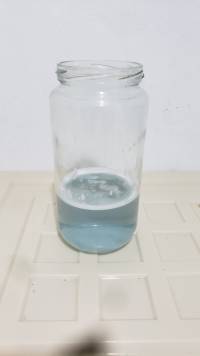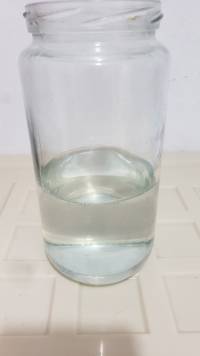Click for SiteMap
Table of Contents
Front Load Washing Machine Hacks
More Effective Rinsing
An inherent issue with front load washers, and perhaps top loaders as well, is that some soapy water remains in the pump after the wash cycle and before the rinse cycle. The soapy water then gets mixed with the rinse water. It's more of an issue with front loaders because they use so much less water. Since some water always remains at the pump, the result is that the clothes are not fully rinsed of soap, even with a second rinse cycle.
I use the minimum amount of soap, the lowest marker on the cap of the laundry detergent.
I emptied the pump using the drain tube located in a panel on the front of the washer and took a photo.
Below sequential images of the water in the pump 1) after the wash cycle, 2) after the rinse cycle, and 3) after the second rinse cycle.
The image after the wash cycle, before the start of the rinse cycle, shows a strong content of soap despite using the first fill line in the detergent cup.
The water left in the pump will mix with incoming water at the start of a rinse cycle, so my having removed this water decreased the amount of soap. However, you can see that after 2 rinse cycles, the water is still a light shade of blue.
A hypoallergenic detergent may be better at rinsing off of clothes. You can also use less than the minimum.
If your clothes have stains, it's better to treat them before the wash than adding more soap to the wash. Treat them either by soaking or by applying stain remover directly to the stain and letting dry.
Increasing the default level of the water will help in rinsing and, subjectively, in washing performance, as mentioned in the following how-to video.
I became curious about raising the water level because I expected clothes to be tumbling in and out of water. Instead I could barely make out any water level. It was like watching tumbleweeds in the Arizona desert.
eaMmOhV1Kdo
I increased the default water level for my machine. The result below from having used the first fill line of the detergent cup, and without emptying the pump after the wash nor after the first rinse cycle. The condition of the water left at the pump after the machine finishes is pretty clear. Not bad!
The higher default water level in the machine dilutes the soap enough to have a decent final rinse.
With the increase in water use, I've had to increase the amount of soap I use otherwise I see no suds in the wash cycle. I think there should be a little bit of suds, but maybe I'm wrong about this.
One more advice from Delia Ann Jones on Quora: Vinegar in the rinse water gets rid of excess soap suds.
Water Temperature
Should I even have this section here? Most people will already know what to do!
Wash in the lowest temperature that will clean your clothes sufficiently. I tend to wash everything in warm water because my clothes get pretty dirty. Warm water is between 90F and 100F (my LG has 30C/86F and 40C/104F options). I've been using 40C, but I think I will use 30C from now on, to save on energy and to keep my darks from fading.
100% wool will shrink to half it's size when washed in 40C water. Some dyes, when washed for the first time, will bleed onto the rest of your clothes, especially in warmer water, and your whites will never be white again. These new items should be soaked separately to bleed out the excess dye.
Maintenance
Drying After Use
- Dry the bottom of the rubber seal of the door with a paper towel.
- Remove the soap dispenser, shake over the sink, and set to dry on the dish rack.
- Dry inside the soap dispenser cave.
- Drain the water out with the hose, then remove the coin catcher and dry inside the coin catcher cave.
- Leave the caves open so the internals can air dry.
Tub Clean Cycle
Many washers have a tub clean cycle. DIY sites recommend adding baking soda, white vinegar, and an essential oil to the washer for the tub clean cycle. Do not add detergent. The baking soda should go first by itself, then the vinegar and essential oil. Baking soda has a high PH and vinegar a low PH. Working alone these can each clean off their respective substrates. That means two tub clean cycles in a row.
Google these sites for measurements. I'm not sure if this is better at cleaning the tub than what companies market for this purpose, but the ingredients are healthier.
According to How to Make a DIY Washing Machine Cleaner, greencitizen.com:
| INGREDIENTS | QUANTITY | ROLE |
|---|---|---|
| Baking soda | ½ to 1 cup | Acts as a gentle scrub |
| White vinegar | 2 to 4 cups | Breaks down mineral deposits |
| Essential oils | 10 drops | Provides a fresh scent and mild disinfection |
This site also offers other alternatives, in a way that is a bit overwhelming, and it isn't clear which of the alternatives to use for what. Don't let it confuse you. Just use the method above as it's predominant on most sites.
Dish soap + washing soda, white vinegar + essential oil are a good replacement for industrial laundry detergent and fabric softener. More details here.
Installation
Does the Drain Pump Need a Constant Back Pressure?
I have the drain routed underneath the washing machine, as the machine sits above an extra sink I don't need to use. However, specifications for the washing machine, or general plumbing, require the drain outlet at a certain height relative to the washer, generally well above the washer drum water level. This prevents water from flowing down the drain when filling the washer.
Although the animation below has nothing to do with a washing machine, the siphoning action when the water is flowing from the right tank to the left tank is the same, where the left side is the drain outlet and the right side is the washing machine drum.
It's the same even though water drops from the end of the drain hose into the standing drain pipe, or in my case, the sink drain.
DlRMkQDLGHg
At the moment, my washer has no siphon break, but no siphoning occurs when the washer fills, because the drain hose curves along the top of the washer, well above the water level in the drum. (Nothing to do with this, but I think there may be a one way check valve so that any water left in the drain doesn't flow back to the drum.)
Some siphoning action may be triggered when the pump actuates water flow. However, I don't know how and if this could be harmful. Who cares if the pump doesn't need to work hard once the water starts siphoning itself down the drain?
I don't have an answer. At the moment everything seems to work fine.
Drying
Hang Dry
It's ok to leave overnight. Many on the mumsnet forum hang clothes at night and take down the next day before sunset. I've hung to dry at 10am, and around 5pm the clothes still need more time, so leave overnight.
Dryer Optimization
Use Low Heat
Less energy is expended, and your clothes will last longer if you use low heat and dry for a longer period of time. The dryer fan and tumbling motor consume less energy than the heating elements.
I have a really cheap dryer with a weak fan. It's the only low profile dryer I could find that would fit stacked above the front loading washer I wanted. I may look at replacing the fan with a more potent one.
Everything Together or Separate Loads
Some heavy articles take longer to dry, so should you dry two separate loads? You want to protect clothes that dry faster from getting over-cooked.
Instead of two loads. I think that you run the dryer for less time overall if you first run the heavy articles for a brief amount of time, then add the lighter items and finish drying everything in one load. If that's true then you save on energy use. The following article agrees with the conclusion: Energy-saving tips for your washing machine and dryer, Cirro Energy.
I think lighter items tumble better when not mixed with heavier items. Lighter items on their own will finish less wrinkled. But saving energy may be more important for you.
Maintaining Leather
In a damp climate, the main adversary is mold. Clean off with a mixture of 50/50 vinegar and water, then apply a fungicide such as cedar oil. Cedar oil is one of the ingredients in the British museum leather conditioner.








Discussion